|
| |
2nd 70mm Festival, Imperial Bio
26 - 30 April 2009 - Copenhagen, Denmark
|
Read more
at
in70mm.com
The 70mm Newsletter
|
|
Written
by: Thomas Hauerslev |
Date:
03.11.2008 |
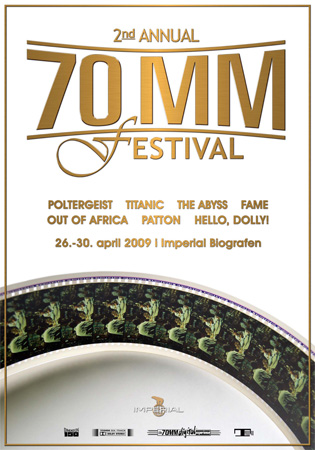 Festival
teaser poster by Teis M. Nielsen Festival
teaser poster by Teis M. Nielsen
Nordisk
Film Biografer, Imperial Bio and in70mm.com are taking great pride in
inviting you to experience something completely unique which you cannot get
in any other Danish cinema.
It is our pleasure to present some of the finest films produced by Hollywood
during the 1980s, and also a pair of true large format 70mm classics. All
films are presented in their original 70mm versions, which means LARGE
FORMAT and full blown 6-track Dolby Stereo.
The large format classics are presented in brand new 70mm prints and are
shown in their original "road-show" version, including overture,
intermission music and Entr’acte and 6-track state of the art digital sound.
Because 70mm film is about 3 times the size of ordinary 35mm film, it is
incredibly sharp. It has unprecedented image steadiness on the huge curved
screen, which means it is almost like looking out of a window to the real
world. The image is VERY sharp; contrast and color *) is AMAZING; and the image
on the screen is MUCH Brighter. This is really a High-Definition experience.
*) "Poltergeist" and "Fame" are vintage 70mm prints with some color fading
present.
|
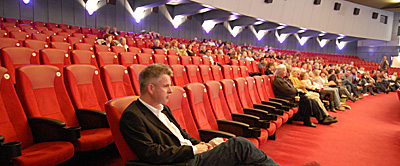 Take
a seat for 5 days with 70mm film Take
a seat for 5 days with 70mm film
This is a unique "as it should be"
cinema experience at Imperial Bio.
Take this opportunity to see how films are presented when the presentation
is second to none.
Come and enjoy 70mm and 6-track stereophonic sound at Imperial Bio's large
curved 120 square meter screen.
Welcome
Lars Møller (Nordisk Films Biografer) &
Thomas Hauerslev (in70mm.com)
|
Tickets
|
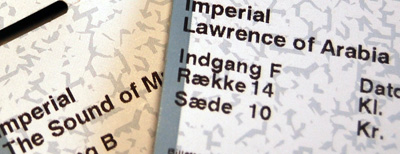 Ticket
sale from kino.dk
has started already
and ticket price is: Ticket
sale from kino.dk
has started already
and ticket price is:
DKK
85/95/105 kr/ticket for films under 150 minutes.
DKK
105/115/125 kr/ticket for films longer than 150 minutes.
All films are in original English version. How to use kino.dk |
|
Imperial Bio 70mm Film Festival 2009
|
|
Sunday, 26. April |
11:30 "Out of Africa"
15:00 "Hello, Dolly!"
18:30 "The Abyss"
21:30 "Poltergeist" |
|
Monday, 27. April |
11:30: "Titanic"
15:30: "Fame"
18:30: "Poltergeist"
21:15: "Fame" |
|
Tuesday, 28. April |
11:30: "Poltergeist"
15:30: "Titanic"
19:45: "Out of Africa" |
|
Wednesday, 29. April |
11:30: "Hello, Dolly!"
15:00: "The Abyss"
18:30: "Poltergeist" |
|
Thursday, 30. April |
11:30: "Patton"
15:30: "Fame"
18:15: "Hello, Dolly!"
21:30: "Patton" |
| The organisers wish
to thank the following individuals and organisations for their help
and support. |
- Schaun Belston & Kevin Barret, 20th Century Fox, LA,
USA
- Sue Jones & Andrew Youdell, BFI, London
- Fox Film Danmark
- UIP, Danmark
- Johan Ericsson, Swedish Film
Institute
-
Citadel
- Geraldine Higgins, Hollywood
Classics, London
- Jes Graversen, Miracle Film
|
 Guide
to kino.dk Guide
to kino.dk
By Søren Søndergaard
The easiest way to get 70mm film tickets in Copenhagen
is by telephoning kino.dk or buy online. So here's a
guide in English. |
|
|
More
in 70mm reading:
How to use kino.dk
The Making of the Festival
2008 Festival
2008 Festival Gallery
2008 Festival Review
Imperial Bio
Nordisk Film
3 Giant Cinemas
The Ideal Kinema,
April 12, 1962
PDF:
Download teaserposter as PDF
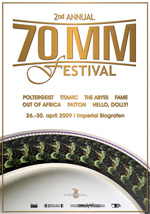 |
Program
|
"The Abyss" / "Dybet"
|
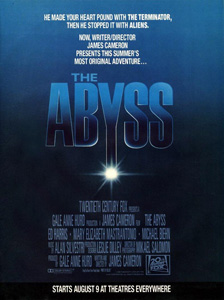  “The
Abyss” (2:18).
Filmed in: 35mm, 4 perforations, 24 frames pr. second.
Principal photography in: Panavision Super 35. Presented:
the curved screen in
70mm and 6-track Dolby Stereo, format 43.
Aspect ratio: 2,21:1. Country of origin: USA. Production
year:
1989.
World premiere: 09.08.1989, Los Angeles, USA. Danish
premiere:
14.10.1989, Scala Biograferne. “The
Abyss” (2:18).
Filmed in: 35mm, 4 perforations, 24 frames pr. second.
Principal photography in: Panavision Super 35. Presented:
the curved screen in
70mm and 6-track Dolby Stereo, format 43.
Aspect ratio: 2,21:1. Country of origin: USA. Production
year:
1989.
World premiere: 09.08.1989, Los Angeles, USA. Danish
premiere:
14.10.1989, Scala Biograferne.
Written and directed by James Cameron. Produced by Gale Anne Hurd. Music by Alan Silvestri.
Photographed by Mikael Salomon. Edited by Conrad Buff and
Joel Goodman
Ed Harris (Virgil 'Bud' Brigman), Mary Elizabeth Mastrantonio (Lindsey
Brigman), Michael Biehn (Lt. Hiram Coffey. Leo Burmester (Catfish De Vries),
Todd Graff (Alan 'Hippy' Carnes), John Bedford Lloyd (Jammer Willis)
20th anniversary performance.
Danish 70mm premiere
Academy Award Winner
Best Visual Effects
allmovie.com:
The crew of an experimental, high-tech submersible is called
into action to investigate a mysterious nuclear submarine crash. A series of
strange encounters leads the crew to suspect the accident was caused by an
extraterrestrial craft, and that they may be participating in an encounter
with an alien species. However, in order to make contact, they must not only
brave the abyss, an exceedingly deep underwater canyon, but also deal with
the violent actions of one of their own crew members, an increasingly
paranoid Navy SEAL officer. Approved by director James Cameron, The Abyss:
Special Edition is an extended director's cut of the 1989 underwater science
fiction epic, reinstating nearly a half hour of footage removed from the
original release under studio pressure. Much of the restored footage places
the film's events in a grander political context, as the crew's mission
becomes a factor in the dangerous escalation of nuclear tension between the
U.S. and the Soviet Union. The largest change involves the film's ending,
which provides further information on the aliens' mission on Earth, bringing
the film to closer to Cameron's intention: a modern remake of Robert Wise's
The Day the Earth Stood Still.
|
"Fame"
|
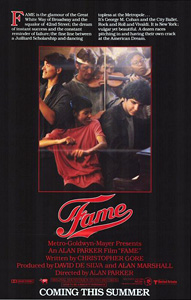  “Fame” (2:14).
Filmed in: 35mm, 4 perforations, 24 frames pr. second.
Principal photography in: 1,85:1. Presented:
on the curved screen
in 70mm with 6-track Dolby Stereo, format 42.
Format: 1,85:1. Country of origin: USA. Production year:
1980.
World premiere: 16.05.1980, Los Angeles, USA. Danish
premiere:
19.09.1980, Tivoli Bio. “Fame” (2:14).
Filmed in: 35mm, 4 perforations, 24 frames pr. second.
Principal photography in: 1,85:1. Presented:
on the curved screen
in 70mm with 6-track Dolby Stereo, format 42.
Format: 1,85:1. Country of origin: USA. Production year:
1980.
World premiere: 16.05.1980, Los Angeles, USA. Danish
premiere:
19.09.1980, Tivoli Bio.
Directed by Alan Parker. Written by Christopher Gore. Produced by David
De Silva and
Alan Marshall. Music by Michael Gore. Photographed by Michael Seresin.
Edited by Gerry Hambling
Eddie Barth (Angelo), Irene Cara (Coco), Lee Curreri (Bruno), Laura Dean
(Lisa), Gene Anthony Ray (Leroy), Debbie Allen (Lydia)
"If they've really got what it takes, it's going to take everything they've
got.."
Danish 70mm premiere
Academy Award Vinder
Bedste soundtrack
Bedste originale sang "Fame"
allmovie.com:
Fame is set at New York's High School of Performing Arts,
where talented teens train for show-business careers. The film concentrates
on five of the most gifted students: singer Irene Cara, actors Paul McCrane
and Barry Miller, dancer Gene Anthony Ray, and musician Lee Currieri. More
so than the subsequent TV series Fame, the film emphasizes the importance of
keeping up one's academic achievements in this specialized school. The
faculty includes no-nonsense English teacher Ann Meara, erudite musical
instructor Albert Hague, and martinet dance teacher Debbie Allen. Of the
film's cast, Ray, Currieri, Allen and Hague were carried over to the TV
version of Fame, which premiered in 1981. The score for the film version of
Fame was honored with an Academy Award.
|
|
|
"Hello, Dolly!"
|
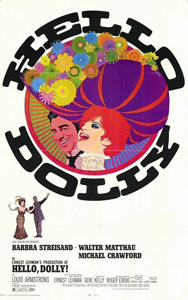 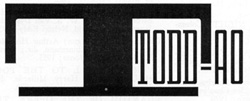 “Hello,
Dolly!”
(2:26) + intermission.
Filmed in: 65mm, 5 perforations, 24 frames pr. second.
Principal photography in: Todd-AO. Presented on:
the curved screen
in Todd-AO
and 6-track DTS digital sound.
Format: 2,21:1. Country of origin: USA. Production year:
1969.
World premiere: 16.12.1969,
Rivoli,
NYC, USA. Danish
premiere:
14.04.1970,
3
Falke Bio. “Hello,
Dolly!”
(2:26) + intermission.
Filmed in: 65mm, 5 perforations, 24 frames pr. second.
Principal photography in: Todd-AO. Presented on:
the curved screen
in Todd-AO
and 6-track DTS digital sound.
Format: 2,21:1. Country of origin: USA. Production year:
1969.
World premiere: 16.12.1969,
Rivoli,
NYC, USA. Danish
premiere:
14.04.1970,
3
Falke Bio.
Directed by Gene Kelly. Produced and written by Ernest Lehman. Original
Music by Jerry Herman. Cinematography by Harry Stradling Sr. Film
Editing by William Reynolds. Costume Design by Irene Sharaff.
 Barbra Streisand (Dolly Levi), Walter Matthau (Horace Vandergelder), Michael
Crawford (Cornelius Hackl), Marianne McAndrew (Irene Molloy), Danny Lockin
(Barnaby Tucker), Fritz Feld (Fritz, German waiter), Louis Armstrong (Louis,
Orchestra Leader) Barbra Streisand (Dolly Levi), Walter Matthau (Horace Vandergelder), Michael
Crawford (Cornelius Hackl), Marianne McAndrew (Irene Molloy), Danny Lockin
(Barnaby Tucker), Fritz Feld (Fritz, German waiter), Louis Armstrong (Louis,
Orchestra Leader)
40th anniversary screening
Academy Award Vinder
Best Art Direction-Set Decoration
Best Music, Score of a Musical Picture (Original or Adaptation)
Best Sound
allmovie.com:
Twenty-seven-year-old Barbra Streisand seemed an
inappropriate choice for middle-aged, match-making widow Dolly Levi, but her
energy carries her right through the role and dominates the lackluster movie
around her. The plot, drawn from Thornton Wilder's The Matchmaker (itself
based on a 19th-century British farce), is set in motion when Yonkers feed
store clerk Cornelius Hackl (Michael Crawford) celebrates his promotion by
taking his pal Barnaby Tucker (Danny Lockin) to New York City for a "corking
good time." But Cornelius and Barnaby can't avoid crossing paths with their
boss Horace Vandergelder (Walter Matthau), who'd give them Holy Ned if he
saw them in a fancy restaurant with two fancy girls instead of tending the
store. Mr. Vandergelder himself is the object of Dolly's affections, though
she pretends to have only a professional interest in the widowed merchant,
going through the motions of finding him a new wife when in fact she'd like
to be the lucky bride herself. The film's musical set pieces include a
show-stopping rendition of the title number, with Louis Armstrong more or
less playing himself. The biggest number is "Before the Parade Passes By,"
in which thousands of costumed marchers and atmosphere extras cavort before
a huge replica of a New York City thoroughfare in the 1890s (actually the
main entrance of the 20th Century-Fox studio, with period facades adorning
the office buildings). An artifact of an era in which Broadway musicals were
a significant part of popular culture, Hello Dolly seemed bizarrely
irrelevant in the social turmoil of the late 1960s, and it became one of the
late-1960s big-budget failures that led Hollywood studios toward a different
kind of filmmaking in the 1970s.
|
"Out of Africa" / "Mit Afrika"
|
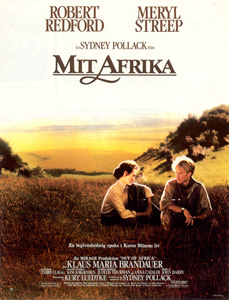  “Out
of Africa”
(2:40).
Filmed in: 35mm, 4 perforations, 24 frames pr. second.
Principal photography in: Technovision. Presented:
on the curved screenin 70mm with 6-track stereophonic Dolby Stereo, format 42.
Format: 1,85:1. Country of origin: USA. Production year:
1985.
World premiere: 18.12.1985, Los Angeles, USA. Dansh premiere:
21.02.1986,
Imperial Bio. “Out
of Africa”
(2:40).
Filmed in: 35mm, 4 perforations, 24 frames pr. second.
Principal photography in: Technovision. Presented:
on the curved screenin 70mm with 6-track stereophonic Dolby Stereo, format 42.
Format: 1,85:1. Country of origin: USA. Production year:
1985.
World premiere: 18.12.1985, Los Angeles, USA. Dansh premiere:
21.02.1986,
Imperial Bio.
Produced and directed by
Sydney Pollack. Screenplay by Kurt Luedtke.
Music by John Barry. Photographed by David Watkin. Edited by Pembroke
Herring, Sheldon Kahn, Fredric Steinkamp and William Steinkamp. Costumes by
Milena Canonero
Meryl Streep (Karen Blixen), Robert Redford (Denys Finch Hatton), Klaus
Maria Brandauer (Bror Blixen / Hans Blixen), Michael Kitchen (Berkeley
Cole), Malick Bowens (Farah), Joseph Thiaka (Kamante)
Images from
the
Danish
1986 premiere
Academy
Award Winner
Best Art Direction-Set Decoration
Best Cinematography
Best Director
Best Music, Original Score
Best Picture
Best Sound
Best Writing, Screenplay Based on Material from Another Medium
allmovie.com:
Out of Africa is drawn from the life and writings of Danish
author Isak Dinesen, who during the time that the film's events occured was
known by her married name, Karen Blixen-Flecke. For convenience's sake,
Karen (Meryl Streep) has married Baron Bor Blixen-Flecke (Klaus Maria
Brandauer). In 1914, the Baron moves himself and his wife to a plantation in
Nairobi, then leaves Karen to her own devices as he returns to his
womanizing and drinking. Soon, Karen has fallen in love with charming white
hunter Denys Finch Hatton (Robert Redford), who prefers a no-strings
relationship. A woman who prides herself on her independence, Blixen finds
herself unhappily in thrall to a aloof man -- and doubly unhappy for living
out such a cliché situation. Although Redford received a lion's share of
criticism for his too-American performance, Streep has rarely been better,
and the film's perfectly measured pace is offset by David Watkin's stunning
location photography. The movie was nominated for 11 Academy Awards and won
7, including Best Picture, Best Director for Sydney Pollack, Best Adapted
Screenplay for Kurt Luedtke, and Best Cinematography for Watkin.
|
"Patton"
|
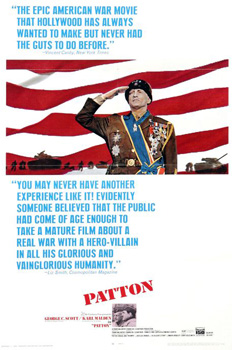 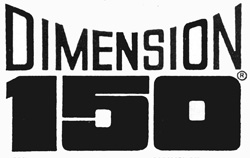 “Patton”
(2:50) + intermission.
Filmed in: 65mm, 5 perforations, 24 frames pr. second.
Principal photogrpahy in: Dimension 150. Presented:
on the curved screen
in
Dimension 150
and 6-track DTS digital sound.
Format: 2,21:1. Country of origin: USA. Production year:
1969.
World premiere:
04.02.1970 Criterion, NYC; USA. Danish
premiere:
22.04.1970 in 35mm with 4-track magnetic stereo at the
Imperial Bio “Patton”
(2:50) + intermission.
Filmed in: 65mm, 5 perforations, 24 frames pr. second.
Principal photogrpahy in: Dimension 150. Presented:
on the curved screen
in
Dimension 150
and 6-track DTS digital sound.
Format: 2,21:1. Country of origin: USA. Production year:
1969.
World premiere:
04.02.1970 Criterion, NYC; USA. Danish
premiere:
22.04.1970 in 35mm with 4-track magnetic stereo at the
Imperial Bio
Directed by
Franklin J. Schaffner. Written by Francis Ford Coppola
& Edmund H. North. Produced by Frank McCarthy. Music by Jerry Goldsmith.
Photographed by Fred J. Koenekamp. Edited by Hugh Fowler
George C. Scott (Gen. George S. Patton Jr.), Karl Malden (Gen. Omar N.
Bradley), Stephen Young (Capt. Chester B. Hansen), Michael Strong (Brig.
Gen. Hobart Carver), Carey Loftin (Gen. Bradley's driver), Albert Dumortier
(Moroccan Minister), Frank Latimore (Lt. Col. Henry Davenport)
40th anniversary screening.
Danish 70mm premiere
 Academy
Award Winner Academy
Award Winner
Best Actor in a Leading Role George C. Scott
Refused to accept the nomination and the award, because he did not feel
himself to be in any competition with other actors.
Frank McCarthy, the film's producer, accepted the award on Scott's behalf at
the ceremony, but returned it to the Academy the next day in keeping with
Scott's wishes.
Best Art Direction-Set Decoration Urie McCleary, Gil Parrondo, Antonio
Mateos & Pierre-Louis Thévenet
Best Director Franklin J. Schaffner
Best Film Editing Hugh S. Fowler
Best Picture Frank McCarthy
Best Sound Douglas O. Williams & Don J. Bassman
Best Writing, Story and Screenplay Based on Factual Material or Material Not
Previously Published or Produced Francis Ford Coppola & Edmund H. North
Academy Award Nomineret
Best Cinematography Fred J. Koenekamp
Best Effects, Special Visual Effects Alex Weldon
Best Music, Original Score Jerry Goldsmith
allmovie.com:
In 1943 North Africa, George Patton (George C. Scott) assumes
command of (and instills some much-needed discipline in) the American
forces. Engaged in battle against Germany's Field Marshal Rommel (Karl
Michael Vogler), Patton drives back "The Desert Fox" by using the German's
own tactics. Promoted to Lieutenant General, Patton is sent to Sicily, where
he engages in a personal war of egos with British Field Marshal Montgomery
(Michael Bates). Performing brilliantly in Italy, Patton seriously
jeopardizes his future with a single slap. While touring an Army hospital,
the General comes across a GI (Tim Considine) suffering from nervous
fatigue. Incensed by what he considers a slacker, Patton smacks the poor
soldier and orders him to get well in a hurry. This incident results in his
losing his command-and, by extension, missing out on D-Day. In his final
campaign, Patton leads the US 3rd Army through Europe. Unabashedly
flamboyant, Patton remains a valuable resource, but ultimately proves too
much of a "loose cannon" in comparison to the more level-headed tactics of
his old friend Omar Bradley (Karl Malden). Patton won 7 Academy Awards,
including Best Picture and Best Actor for Scott, an award that he refused.
|
"Poltergeist"
|
  “Poltergeist” (1:54).
Filmeed in: 35mm, 4 perforations, 24 frames pr. second.
Principal photography in: Panavision. Presented:
on the curved screen
in 70mm with 6-track stereophonic Dolby Stereo, format 42.
Format: 2,21:1. Country of origin: USA. Production year:
1982.
World premiere: 04.06.1982, Los Angeles, USA. Danish
premiere:
03.09.1982, Palads Teatret. “Poltergeist” (1:54).
Filmeed in: 35mm, 4 perforations, 24 frames pr. second.
Principal photography in: Panavision. Presented:
on the curved screen
in 70mm with 6-track stereophonic Dolby Stereo, format 42.
Format: 2,21:1. Country of origin: USA. Production year:
1982.
World premiere: 04.06.1982, Los Angeles, USA. Danish
premiere:
03.09.1982, Palads Teatret.
Directed by Tobe Hooper. Written and produced by Steven Spielberg. Music by Jerry Goldsmith.
Photographed by Matthew F. Leonetti. Edited by Michael
Kahn
Craig T. Nelson (Steve Freeling), JoBeth Williams (Diane Freeling), Beatrice
Straight (Dr. Lesh), Dominique Dunne (Dana Freeling), Oliver Robins (Robbie
Freeling), Heather O'Rourke (Carol Anne Freeling)
"They're here"
Danish 70mm premiere
Academy Award nominated
3 Academy Awards
allmovie.com:
With Poltergeist, directed by Tobe Hopper, Steven Spielberg
had his first great success as a producer. Released around the same time as
Spielberg's E.T., the film presents the dark side of Spielberg's California
suburban track homes. The film centers on the Freeling family, a typical
middle class family living in the peaceful Cuesta Verde Estates. The father,
Steve (Craig T. Nelson), has fallen asleep in front of the television, and
the dog saunters around the house revealing the other family members --
Steve's wife Diane (JoBeth Williams), sixteen-year-old daughter Dana
(Dominique Dunne), eight-year-old son Robbie (Oliver Robins), and
five-year-old Carol Ann (Heather O'Rourke). Soon strange things begin to
happen around the house; the pet canary dies, mysterious storms occur, and
Carol Ann is summoned to the TV set, where a strange shaft of green light
hits her and causes the room to shake ("They're he-e-ere!"). As curious
events continue, Carol Ann is repeatedly drawn to the television, where she
begins to talk to "the TV people." Soon Carol Ann is sucked into a closet,
disappearing from this reality plane. Unable to find his daughter, Steve
consults Dr. Lesh (Beatrice Straight), a para-psychologist from a nearby
college. Lesh finds that paranormal phenomena is so strong in the Freelong
household she is unable to deal with it and sends for clairvoyant and
professional exorcist Tangina (Zelda Rubinstein) to examine the house in
hopes of finding Carol Ann. Tangina makes a horrifying discovery: Carol Ann
is alive and in the house, but is being held on another spectral plane.
|
"Titanic"
|
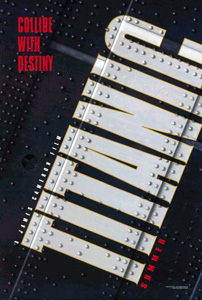  “Titanic”
(3:14).
Filmed in: 35mm, 4 perforations , 24 frames pr. second.
Principal photography in: Panavision Super 35 cameras and lenses.
Presented:
on the curved screen in Panavision 70mm with
6-track DTS
digital sound.
Format: 2,21:1. Country of origin: USA. Production year:
1997.
World premiere: 14.12.1997 Los Angeles, USA. Danish premiere:
28.01.1998,
Imperial Bio. “Titanic”
(3:14).
Filmed in: 35mm, 4 perforations , 24 frames pr. second.
Principal photography in: Panavision Super 35 cameras and lenses.
Presented:
on the curved screen in Panavision 70mm with
6-track DTS
digital sound.
Format: 2,21:1. Country of origin: USA. Production year:
1997.
World premiere: 14.12.1997 Los Angeles, USA. Danish premiere:
28.01.1998,
Imperial Bio.
Writtem, directed and produced by James Cameron. Music by James Horner.
Photographed by Russell Carpenter.
Edited by Conrad Buff, James Cameron and Richard A. Harris.
Leonardo DiCaprio (Jack Dawson), Kate Winslet (Rose DeWitt Bukater),
Billy Zane (Caledon 'Cal' Hockley), Kathy Bates (Molly Brown), Frances
Fisher (Ruth Dewitt Bukater), Gloria Stuart (Old Rose), Bill Paxton
(Brock Lovett) and Bernard Hill (Captain Smith)
Academy
Award Vinder
Best Art Direction-Set Decoration
Best Cinematography
Best Costume Design
Best Director
Best Effects, Sound Effects Editing
Best Effects, Visual Effects
Best Film Editing
Best Music, Original Dramatic Score
Best Music, Original Song
Best Picture
Best Sound
allmovie.com: This
spectacular epic re-creates the ill-fated maiden voyage of the White Star
Line's $7.5 million R.M.S Titanic and the tragic sea disaster of April 15,
1912. Running over three hours and made with the combined contributions of
two major studios (20th Century-Fox, Paramount) at a cost of more than $200
million, Titanic ranked as the most expensive film in Hollywood history at
the time of its release, and became the most successful. Writer-director
James Cameron employed state-of-the-art digital special effects for this
production, realized on a monumental scale and spanning eight decades.
Inspired by the 1985 discovery of the Titanic in the North Atlantic, the
contemporary storyline involves American treasure-seeker Brock Lovett (Bill
Paxton) retrieving artifacts from the submerged ship. Lovett looks for
diamonds but finds a drawing of a young woman, nude except for a necklace.
When 102-year-old Rose (Gloria Stuart) reveals she's the person in the
portrait, she is summoned to the wreckage site to tell her story of the
56-carat diamond necklace and her experiences of 84 years earlier. The scene
then shifts to 1912 Southampton where passengers boarding the Titanic
include penniless Jack Dawson (Leonardo DiCaprio) and society girl Rose
DeWitt Bukater (Kate Winslet), returning to Philadelphia with her wealthy
fiance Cal Hockley (Billy Zane). After the April 10th launch, Rose develops
a passionate interest in Jack, and Cal's reaction is vengeful. At midpoint
in the film, the Titanic slides against the iceberg and water rushes into
the front compartments. Even engulfed, Cal continues to pursue Jack and Rose
as the massive liner begins its descent.
|
|
|
Why 70mm is so Special
|
|
 "Lawrence
of Arabia" - The ultimate 70mm film.
Copyright SONY/Columbia Pictures 2008. Published with
permission "Lawrence
of Arabia" - The ultimate 70mm film.
Copyright SONY/Columbia Pictures 2008. Published with
permission
The audience get a
lot more out of a film, if presented in 70mm with razor sharp images and
crystal clear sound. Films presented in 70mm are an intensive experience,
very realistic and almost three dimensional. It is an experience which makes
everything you have ever seen on film before pales into insignificance. The
audience really get value for their money!
|
|
The Imperial Bio
|
|
 70mm
is best experienced in a large cinema of
Imperial Bio's
size. Come and experience the grandeur and sensation of “being in the
movies”. Imperial Bio is ideal with 24 curved rows and 1102 comfortable
seats. The curved screen is a rare thing these days, but the curve and the
curved seating ensures the best view of the screen from all seats in the
house. 70mm
is best experienced in a large cinema of
Imperial Bio's
size. Come and experience the grandeur and sensation of “being in the
movies”. Imperial Bio is ideal with 24 curved rows and 1102 comfortable
seats. The curved screen is a rare thing these days, but the curve and the
curved seating ensures the best view of the screen from all seats in the
house.
Imperial Bio
opened in 1961 and was from the beginning built for "Road-Show" movies, and
is today, the only remaining Danish cinema of this type. This is a rare
chance to see the cinema classics in the world’s best film format, in the
finest cinema in Denmark; The best at the best.
|
|
|
|
|
|
|
|
Go: back
- top - back issues
- news index
Updated
22-01-25 |
|
|

 "Lawrence
of Arabia" - The ultimate 70mm film.
Copyright SONY/Columbia Pictures 2008. Published with
permission
"Lawrence
of Arabia" - The ultimate 70mm film.
Copyright SONY/Columbia Pictures 2008. Published with
permission 70mm
is best experienced in a large cinema of
Imperial Bio's
size. Come and experience the grandeur and sensation of “being in the
movies”. Imperial Bio is ideal with 24 curved rows and 1102 comfortable
seats. The curved screen is a rare thing these days, but the curve and the
curved seating ensures the best view of the screen from all seats in the
house.
70mm
is best experienced in a large cinema of
Imperial Bio's
size. Come and experience the grandeur and sensation of “being in the
movies”. Imperial Bio is ideal with 24 curved rows and 1102 comfortable
seats. The curved screen is a rare thing these days, but the curve and the
curved seating ensures the best view of the screen from all seats in the
house. 


 Ticket
sale from
Ticket
sale from 



 “Hello,
Dolly!”
(2:26) + intermission.
“Hello,
Dolly!”
(2:26) + intermission. 


 “Patton”
(2:50) + intermission.
“Patton”
(2:50) + intermission. 
